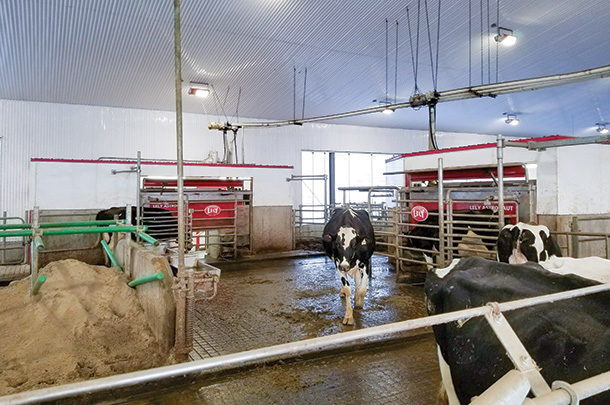As you ponder this question, consider the following: 1) It runs every day. 2) It runs for multiple hours each day. 3) On many dairies, it runs around the clock, every day. 4) It harvests your most valuable crop.
Did you think of your milking equipment? In almost every case, milking equipment is the most important tool for any dairy farm, and it typically has the absolute best return on investment (ROI). Why? Because it runs more hours each year than any other equipment, and it continually harvests your daily crop of milk, often 24-7. To check this claim, consider these examples:
Even a very small dairy uses its milking equipment 1,460 hours per year (milking 2 hours, twice daily) as calculated at 4 hours per day X 365 days = 1,460 hours. On a large dairy milking 24-7, that number is a whopping 8,760 hours per year (24 hours per day X 365). If milking equipment on a large dairy is 20 years old, it has over 175,000 running hours. If it’s 30 years old, it totals over 262,800 hours. Do the math and find the answer for your farm, keeping in mind that your facility (building) is probably at least the same age or older.
Can you think of any other piece of equipment that even comes close? Possibly the water supply pumps, feed mixer or skid steer, but usually not to this extent. In the same time period the older milking parlor is still operating, many dairies are probably using their third to fifth generation of tractors and other field equipment. How many tractors do you have with well over 100,000 hours?
A testament to the terrific payback of milking equipment is that it can be used for 20 to 30 years and in that time be leveraged to pay for many other things on the dairy.
If your milking equipment has significant accumulated hours (100,000 to 300,000), does it make financial sense to continue using it? If so, for how much longer? Consider these questions to evaluate:
- How old is your equipment and facility?
- Is it in top operating condition, or are you sacrificing performance?
- What is the maintenance cost?
- What is the expense of lost efficiencies?
- Is it as labor efficient as newer alternatives?
- Is it energy efficient?
- Are there herd management benefits that could be obtained with newer technology?
- Does it offer animal welfare benefits for your cows and a positive perception for your consumers?
- Would you be proud to welcome visitors to see your equipment and facility in operation?
Does your field equipment have a much higher level of technology? If so, have you considered the benefits your herd and milk crop might likely realize every day from a similar level of technological sophistication? Is your daily, perennial crop (milk) at least as important as your seasonal crops? More so?
If you feel you have significant life left on your milking equipment hardware or facility, you may want to consider what you might gain from new technology, equipment and improved herd management concepts. A 20- to 30-year-old corn planter will still deliver a crop, but newer planter technologies give you the ability to improve on yields, sometimes to a great extent. For your particular situation, is it still wise to operate older equipment simply because it’s paid for itself many times over?
Milking equipment is simply a tool, a milk-harvesting machine. Just like a forage harvester doesn’t guarantee the yield of the crop, milking equipment by itself will not make you more milk, but it does offer tools to help you do so. Newer equipment can be more labor efficient and enhanced with newer technologies to enable you to harvest more milk, of better quality, while offering cows a better experience and quality of life.
Separate apples from oranges
While all milking equipment gets the milk from the cow, consider the differences in milking equipment type and concept to determine your ROI and what’s best for your situation. This answer really depends upon the results you’re realizing today and what it takes to get them (more labor?) versus what your results would be with a new system (more milk with less labor?).
Today, more than ever before, the level of risk associated with milking equipment purchases is relative to the depreciation rate of the equipment. This directly relates to the specific equipment, its associated technology and the opportunity that might be forfeited by further utilizing conventional methods (primarily a chance to reduce labor costs). Our dealership has sold parlors for 28 years and milking robots for nearly 13 years. In that time, we have seen a dramatic shift to robotics, even in larger herds.
We have seen only two dairy customers sell their robots; one retired from dairying and the other wanted to upgrade to the latest technology. In these two examples, the robots were between 6 and 10 years old and were resold for 50% to 70% of their new value. Other areas of the country have seen similar resale value experiences. A similarly aged conventional-system milking parlor would probably be worth 10% to 20% of its new value in the same time period, and requires more labor to disassemble, move and reinstall.
Most new parlors are still set up to operate with a labor-intensive concept and few new advantages for cows. In comparison, box-style milking robots offer advantages for cows that parlors cannot. The technology on 10-year-old robotics is still very applicable, as new options and software can potentially be added to previous models.
To further illustrate the risk component, a lender recently told me they would not finance a parlor project for one of our customers with excellent financials since there is not enough security in the parlor equipment (higher risk). This same lender said this dairy would not have this concern if they were adding robots. Robotics have very good resale values due to a higher level of demand. This lowers the risk and depreciation loss for the equipment.
Is it time to consider milking equipment improvements that offer you a great ROI? If the older parlor equipment is in really good shape, has a very high level of current technologies, you don’t have current and future labor concerns, and it’s still able to meet your goals and challenges, maybe not. The real question is, how long will these conditions last, and what might you sacrifice by waiting?
Finger Lakes Dairy Services (established 1991) has been a Lely robotics dealer since 2007. Whitney Davis has specialized in milking equipment, project design, systems management and investment economics since 1993.

-
Whitney Davis
- Robotic Systems Specialist
- Finger Lakes Dairy Services
- Email Whitney Davis











